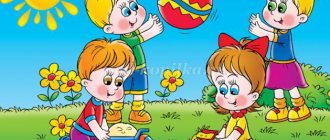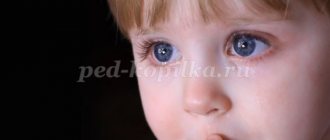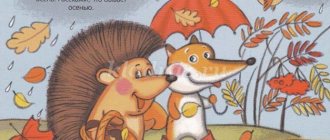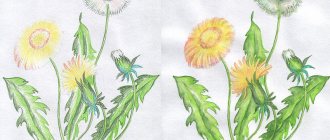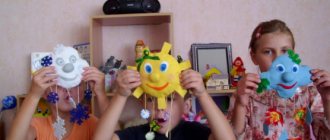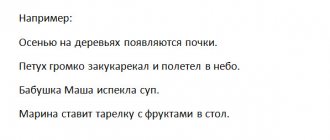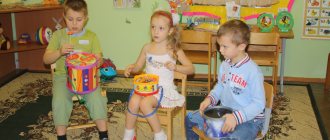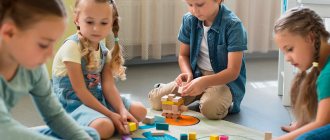Card index of walks in the senior group “December”
Ice-strongman experience
- pour water into a bottle and put it in a snowdrift at the end of the walk, examine the bottle, it is cracked - the volume of ice is always greater than the volume of water from which it was made; learn to draw conclusions.
Labor activity
: Clearing the area of snow
Target:
reinforce ideas about the protective properties of snow.
Outdoor games:
“Entertainers”, “Firemen in training”
Target:
strengthen the ability to run, dodge a trap, crawl under an obstacle. "Find yourself a mate"
Target:
develop agility, balance, endurance, spatial orientation
Individual work:
Development of movements
Target:
learn to throw snowballs into the distance.
Games at the request of children
Walk 2
Bird watching in winter
Target:
to form an idea of bird life in winter; cultivate a desire to take care of birds, highlighting signs of living things.
Progress of observation
There are no paths visible in the forest, fly, birdie, to people
The bushes are standing in sheepskin coats. And quickly hide outside the window,
Dormant beetles and larvae And we will feed you
Covered by snowfall under the bark. Bread crumbs, millet.
What birds do you see near your home in winter?
Why do they fly to human habitation? Why do people set up bird feeders in winter? Why do wintering birds need to be fed? Do many birds come to our feeders? What kind of food do they eat more readily? What else did you see while watching the birds at the feeder? Is there a feeder near your house?
Labor activity:
Clearing the area of younger preschoolers from snow.
Target:
cultivate a desire to help younger people.
Outdoor games :
"Cunning Couple"
Target:
develop your eye, achieving good results.
"Hit the target"
Target:
learn to follow the direction of a flying object, calculate and perform movements. "Frost - Red Nose"
Target:
learn to deftly and quickly run across the site;
Drawing
“Snow Artist” - Paints can be splashed on the snow and then sculpted from it. Or spray ready-made figures. Or just draw a picture directly in the snow.
Target:
develop creativity and imagination
Individual work:
Throwing snowballs into the distance and at the target.
Target:
develop coordination of movements.
Games at the request of children
An evening walk
Zimushka - winter
Target:
systematize children’s understanding of the characteristic signs of winter, and be able to talk about it beautifully.
Progress of observation
Who whitens the clearings with white, Sews feather beds,
And writes on the walls with chalk, Decorated all the windows?
Who knows the answer? What can you tell us about winter? (Cold, harsh, frosty, fierce, blizzard, angry, long.) After what does winter come? Name the winter months. What happens in nature in winter? What kind of trees are there? What lies on the roofs of houses and on the street? What do people wear in winter? How do animals and birds live in winter? Why? How can you help them? What winter holidays do you know? Children, think about how you can say beautiful things about snow and trees? (The snow lies in a wavy carpet and shimmers, sparkles, sparkles from the sun’s rays. There is fluffy, white, soft snow around and sparkles with multi-colored lights. Winter has dressed the trees in warm snow coats.) Now let’s come up with a story about the beauty of the winter forest. You must talk about the weather, the snow, the beauty of the trees, and what mood
Winter walk in the senior group. Abstract
Summary of a winter walk in the senior group of a kindergarten on the topic “Observing snowfall”
Author: Marina Viktorovna Vitskova, teacher of the MBDOU “Kindergarten “Goldfish” of the Astrakhan region, Chernoyarsk district. Description: using this material, children develop observation, curiosity, and attention. This material will be useful for parents and kindergarten teachers when conducting winter walks for older children. Goals: Continue to introduce natural phenomena; to develop cognitive interest and the ability to observe the world around them. Types of activities: gaming, cognitive-research, communication, basic household work. Materials : shovels, buckets, toys for children.
Progress of the walk
Watching snowfall.
Educator. Guys, look and tell me how it snows? Children. Snow falls to the ground quietly, snow falls in different directions. Educator. Snow is falling - this phenomenon is called snowfall (snow falls in flakes, snowflakes slowly fall on trees, on the roofs of houses, on the ground). Look how big the snowdrifts are on our site. Let's do an experiment with you. Why is the snow light? Children. The snow is soft, white, fluffy.
Conducting the experiment: “Why is the snow light?”
Goal: Improve children's knowledge about snow. Educator. Guys, let's shovel the snow into a pile with buckets. Now tell me, which snow buckets are light or heavy? Children. Snow buckets are lightweight. Educator. Remember, your children used to carry buckets of sand in the summer. Which sand bucket was light or heavy? Children. Sand buckets are heavy. So what about snow? Children. Snow is lighter than sand. Educator. What else could be heavier than snow? Children. Earth, water Educator. That's right, well done. Educator. Children, tell me what signs about snow do you know? Children. There will be a lot of snow - there will be a lot of bread. When the snow falls tightly to the fences - a bad summer. Snow sticks to the trees - it will be warm. The sun sets in the clouds - it will snow. It dawns quickly - it will snow. Clouds go against the wind - to the snow. Educator. What proverbs and sayings about snow do you know? Children. More snow in the fields means more bread in the bins. If a snowflake blows up, there will be more bread; if water spills, there will be hay. No matter how you wash, you will not be whiter than snow. Speeches are like snowflakes, but deeds are like soot. It’s not the snow that’s blowing, but the snow that’s coming from above. The first snowflake falls forty days before winter. Where there is snow, there is a trace: there was no snow, there was no trace. Educator. Well done boys.
Now tell me poems about snow. Children recite poems.
Here winter played snowballs, threw up a lot of snow, There is no way at all now, You can’t get through, you can’t get through!
In a snowy downy bed Pines are drowning, spruce trees are drowning... Everyone in the snow has become warmer, Snow is like a blanket for everyone! The first snow covered the ponds with ice. And the last rowan tree is pecked by blackbirds in reserve. Ice is transparent, fragile, thin - Don't go on the ice, child! White, delicate fluffy snow is spinning, falling, flying! White, sparkling pure, Lies on the ground, sparkling! Gently covers the earth, flutters in the air in a whirlwind! Dresses everything up with itself, amazes with beauty! The snow casts a spell, it snows, the snow blows snow... It swirls in the air, does not melt, It turns silver and sparkles... He wants to create magic, He will prophesy a fairy tale for us... The snow swirls, the snow swirls And lies on the fields All the roads are swept away This snowy winter The kids really like it Play sometimes have a snowball fight Ride on a sled Straight from the icy hill, Take skates or skis with you And rush to the skating rink, or to the forest! Educator. Guys, guess the riddle.
Mystery.
All day long, he flew, turning white, to the boulevards and alleys, lay down in the snowdrifts for the night... You guessed it!
This…. Children. Snow
Individual work.
Exercise children in throwing snowballs at a distance with their left and right hands.
Labor activity. “Remove snow from the paths” Goal: to involve children in performing simple tasks.
Game activity.
An outdoor game is being played: “Hunter and Hares” Purpose: to learn to throw a ball at a moving target. Progress of the game: On one side there is a “hunter”, on the other there are 2-3 “hares” in drawn circles. The “hunter” walks around the area, as if looking for traces of “hares,” then returns to his place. The teacher says: “The hares ran out into the clearing.” "Hares" jump on two legs, moving forward. At the word “hunter”, the “hares” stop, turn their backs to him, and he, without leaving his place, throws the ball at them. The “hare” that the “hunter” hit is considered shot, and the “hunter” takes it to himself. Educator. Children, did you enjoy the walk? What did we learn about snow today? What did you like most? Children talk about what they did, what they learned new, what they would like to learn more.
We recommend watching:
Summary of a lesson on the surrounding world for the senior group “Hello, Zimushka-Winter!” Summary of a lesson for older preschoolers “Hello, winter - winter” Summary of GCD in the senior group: How animals prepare for winter Summary of GCD on cognitive development in the senior group on the topic: Winter
Similar articles:
Walk “Wind Watching” in the senior group
Summary of the lesson “Birds in winter.” Senior group
Summary of a lesson on ecology in the senior group in kindergarten. Birds in the forest
Summary of a music lesson in kindergarten in the senior group on the topic: Winter
Entertainment “Visiting Winter” in kindergarten in the senior group
